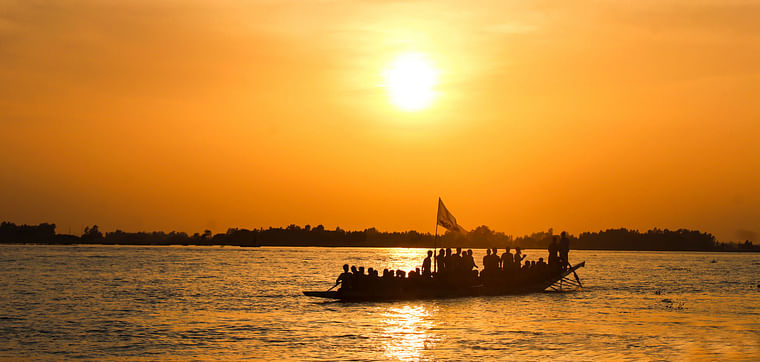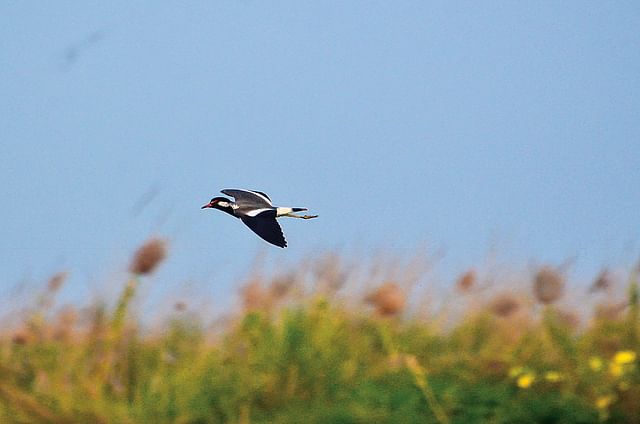Chalan Beel in autumn

Chalan Beel. The name itself conjures up images of a vast wetland, waves and a macabre majesty that stretches out to the horizon. That is the ‘beel’ in the monsoons. But it changes with the waxing and waning of the seasons. In autumn it first takes on an emerald hue, then gradually fills with the fragrance of the golden harvest of ripened paddy.
The changing charms of Chalan Beel in autumn have a very special appeal. Above the expanse of the marshy wetland, white clouds are scattered over the canopy of the blue sky. There are flowers everywhere and the cry of birds fills the air. Here and there fishermen fill their boats with their abundant catches. Yes, autumn is the best time time visit Chalan Beel.
It is said that back in the day, the rajas and maharajas, the Mughals and the Pathans would come here, lazily relaxing in their boats on the beel. Tourists were in awe of the sheer expanse of the water body. Writers were inspired by the rippling waters. Feasts were cooked with the delicious fish of Chalan Beel. Times have changed and much of the past glory has diminished. But is still draws in hordes of visitors to take in its splendour.

The calm autumn sky fills the mind with peace. The canals, marshes, rivers and wetlands are an amazing sight to behold.
Chalan Beel is more than a ‘beel’
It is not known why this vast wetland is referred to as a ‘beel’ or marsh. Chalan Beel, it is said, did not even exist 2000 years ago. It was a part of the sea. Over the centuries, the sea shifted south. The British Gazetteer states that though the sea has moved away, Chalan Beel holds onto its memory. This ‘beel’ is not static, it has an ebb and flow for which it is perhaps called ‘chalan’ (movement) beel.
Chalan Beel itself contains 39 smaller beels, 16 rivers, 22 canals and innumerable ponds.
At one time Chalan Beel was called the haven of fish. The fish would be caught and transported to West Bengal by train. The aristocrats there would feast on the fish. The fish in the beel included rui, katla, chital, boal, shing, magur, koi, shoal, gojar, taki, bain, pabda, tengra, puti, tatkini, bheda and chanda.
Along with the vast water expanse, the green rice fields, the flowers and the birds, there are many sights to visit at Chalan Beel. There is the Chatmohar Shahi Masjid, the Jagannath temple, Faridpur’s Banwarinagar zemindar estate, the Radhagobinda temple, Rashik Mandir, Shiv Mandir, the large ponds Kunjaban Dighi, Ulipur Dighi, Mathura Dighi and Makarson Dighi.
What to see at Chalan Beel
Along with the vast water expanse, the green rice fields, the flowers and the birds, there are many sights to visit at Chalan Beel. There is the Chatmohar Shahi Masjid, the Jagannath temple, Faridpur’s Banwarinagar zemindar estate, the Radhagobinda temple, Rashik Mandir, Shiv Mandir, the large ponds Kunjaban Dighi, Ulipur Dighi, Mathura Dighi and Makarson Dighi.
Next to Tarash is the village Binsara. There you can see ‘Jiyon Kup’, the house of the legendary Behula Sundari’s father Shai Sowdagar. There is the Chalan Beel museum at Gurudaspur, Natore.
How to get there
There is bus service from Dhaka to Kachhikata in Sirajganj, Chatmohor in Pabna or Bhangura in Faridpur. Or one can take a train up to Chatmohor or Bhangura. It is easy to reach Kachhikata from anywhere in the country. From there one can take a boat and go around the beel. Eight kilometres from Kachhikata is the Chatmohor bazaar where you can get delicious rasmalai.
* This write-up appeared in Prothom Alo’s special publication on tourism ‘Barnil Berano’. Extracts from the publication are regularly rewritten in English for readers of the English edition (online) of Prothom Alo










